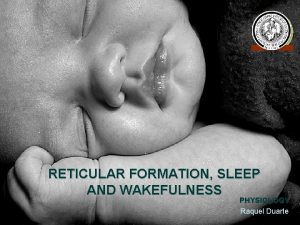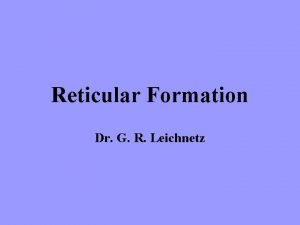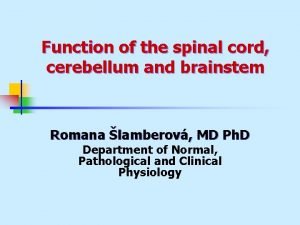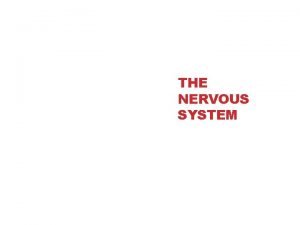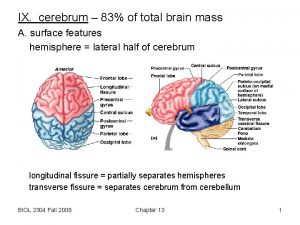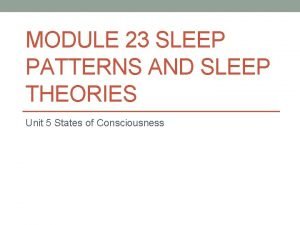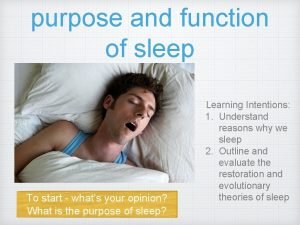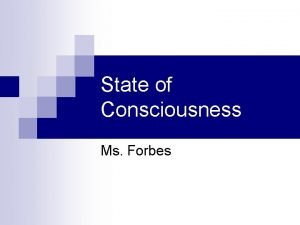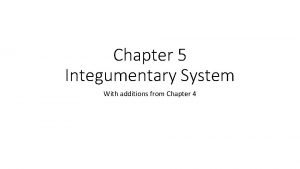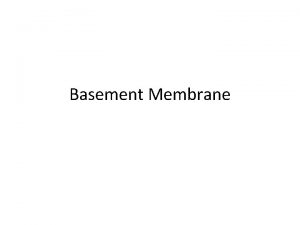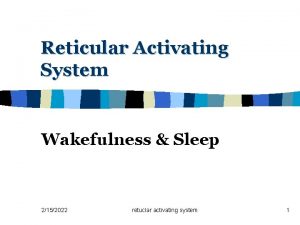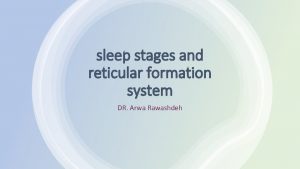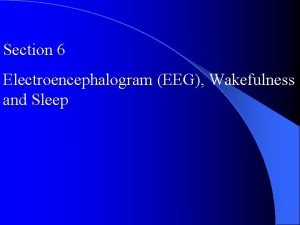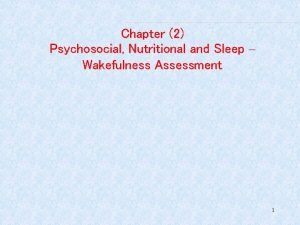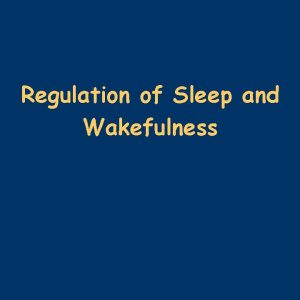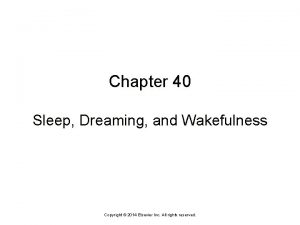RETICULAR FORMATION SLEEP AND WAKEFULNESS Adriana Pereira Group
















- Slides: 16

RETICULAR FORMATION, SLEEP AND WAKEFULNESS Adriana Pereira Group 4 29 th April 2009 Special Neurophysiology

• Reticular Formation Diffused mass of neurons and nerve fibers forming an ill-defined meshwork of reticulum in the central portion of the brainstem. Various nuclei: 1) Nuclei of medullary reticular formation 2) Nuclei of pontine reticular formation 3) Nuclei of midbrain reticular formation Situated: - Downwards into spinal cord - Upwards up to thalamus and subthalamus

Connections of Reticular Formation Fig. 1 -Afferent connections of reticular formation Fig. 2 – Efferent connections of reticular formation

Functional divisions of Reticular Formation Ascending Reticular Activating System - ARAS Receives fibers from the sensory pathways via long ascending spinal tracts. Alertness, maintenance of attention and wakefulness. Emotional reactions, important in learning processes. Tumor or lession – sleeping sickness or coma. Fig. 3 – Brain section.

Descending Reticular System Inhibitory: Facilitatory: - Smoothness and - Mantains the muscle - accuracy of voluntary movements Reflex movements Regulates muscle tone Maintenance of posture Control vegetative functions tone - Facilitates autonomic functions - Activates ARAS

Electroencephalogram (EEG) “Electroencephalog raphy (EEG) is the measurement of electrical activity produced by the brain (cortex!) as recorded from electrodes placed on the scalp. “ Fig. 3 - Waves of EEG.

Physiological changes during sleep Plasma volume decreases Heart rate decreases Blood pressure decreases Rate and force of respiration decreases Salivary secretion decreases Secretion of gastric juice does not alter or slightly increases Formation of urine decreases Sweat secretion increases Lacrimal secretion decreases Muscle tone and reflexes decrease except ocular muscles

Types of sleep Characteristics Rapid eye movement sleep (REM) – “paradoxical sleep” Non-rapid eye movement sleep (NREM) – “dreamless sleep” Rapid eye movement Present Absent Dreams Present Absent Muscle twitching Present Absent Heart rate Fluctuating Stable Blood pressure Fluctuating Stable Respiration Fluctuating Stable Body temperature Fluctuating Stable Neurotransmitter Noradrenaline serotonin

Types of Sleep – REM, Paradoxical Sleep 5 -30 mins long, every 90 mins + muscle tone, + brain metabolism, irregular heart- and respiratory rate, rapid eye movements less restful, desynchronised associated with psychical activities (>dreaming)

Types of Sleep 1 – NREM, Slow wave sleep + restful associated with (viscero-)motor activities 4 Phases: - I (Drowsiness): low voltage fluctuations, alpha waves reduced - II (Light sleep): low voltage of delta waves - III (Medium sleep): f of delta waves reduced, amplitude increases - IV (Deep sleep): delta waves more prominent, low f and high altitude

Sleep Spindle, K-Complex:

Sleep Centres actually generate sleep hypothalamus (ant: awakening, post: sleep) reticular formation area below midpons (cholinergic, serotoninergic ->sleep adrenergic -> wakefulness) sleep generating substances in CSF after long sleep deprivation

Sleep Disorders Insomnia Hypersomnia Narcolepsy and Cataplexy Sleep Apnea Disorder Nightmare Night Terror Somnambulism Nocturnal Enuresis Movement Disorders during sleep

Why do we dream? To exercise the synapses, or pathways, between brain cells, and that dreaming takes over where the active and awake brain leaves off. When awake, our brains constantly transmit and receive messages, which course through our billions of brain cells to their appropriate destinations, and keep our bodies in perpetual motion. Dreams replace this function. Psychological theorists of dreams focus upon our thoughts and emotions, and speculate that dreams deal with immediate concerns in our lives. Dreams can, in fact, teach us things about ourselves that we are unaware of.

Summary : Sleep phases are distinguished by their EEG pattern (non. REM, REM) non. REM is also called “slow wave sleep“, REM “paradoxical sleep“

References Internet: - http: //en. wikipedia. org/wiki/Circadian_rhythm - http: //www. semel. ucla. edu/sleepresearch/sleep. Dream/sleep _dreams. htm - http: //en. wikipedia. org/wiki/Reticular_activating_system - http: //www. coolquiz. com/trivia/explain/docs/dreams. asp Books: - Guyton & Hall, Textbook of Medical Physiology, 11 th Edition, Elsevier - K Sembulingam, Prema Sembulingam, Essentials of Medical Physiology, 4 th Edition, Jaypee
 Reticular formation and sleep
Reticular formation and sleep Ventrolateral preoptik alan
Ventrolateral preoptik alan Reticular formation
Reticular formation Pons function
Pons function Ap psychology midterm review
Ap psychology midterm review Pain in brain stem
Pain in brain stem Reticular formation of brain
Reticular formation of brain Module 16 sleep patterns and sleep theories
Module 16 sleep patterns and sleep theories Module 23 sleep patterns and sleep theories
Module 23 sleep patterns and sleep theories Module 23 sleep patterns and sleep theories
Module 23 sleep patterns and sleep theories Sidney compares sleep with
Sidney compares sleep with Adults spend about ______% of their sleep in rem sleep.
Adults spend about ______% of their sleep in rem sleep. Stratified squamous non-keratinized epithelium
Stratified squamous non-keratinized epithelium Papillary layer
Papillary layer Basement membrane tissue
Basement membrane tissue Lamina
Lamina Adipose connective tissue function and location
Adipose connective tissue function and location
